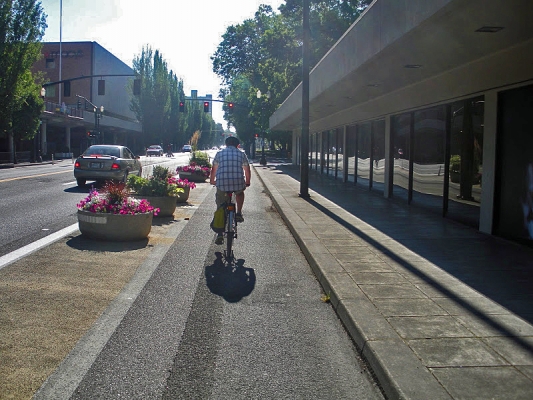
The most recent edition of the Highway Capacity Manual (HCM) contains analysis procedures for measuring the level-of-service (LOS), also referred to as quality of service, provided by an urban roadway to bicyclists. The method uses different design and operating features of the roadway segment (e.g. width, motor vehicle volumes and speeds) to assess an LOS grade of A (best) to F (worst). These procedures are used by planners and engineers to recommend how existing streets could be retrofitted or new streets designed to better serve people on bicycles (and other modes). However, the current HCM does not include methods that address protected bike lanes (aka “cycle tracks” or “separated bike lanes”), only conventional striped bike lanes, shoulders, and shared streets. There are other methods for predicting comfort from a bicyclist’s perspective that do consider protected bike lanes, but they are either based only on expert opinion or on surveys in Denmark.
This presentation will describe how to evaluate the level-of-service of a protected bike lane using results from surveys conducted in the United States. The model developed by this project could be used to supplement the current HCM to objectively consider a wider range of options for improving the environment for bicycling. This is increasingly important as the implementation of, and demand for, protected bike lanes surges around the US.
Nick Foster, AICP, is a senior planner at Kittelson & Associates focused on bicycle and pedestrian planning and multimodal safety analysis. His experience with bicycle facility planning and design ranges from regional plans to corridor-specific designs to research on protected bike lanes and user comfort. Nick has been a guest lecturer in graduate transportation courses at Portland State University on the topic of bicycle and pedestrian facility performance (i.e. level-of-service analysis) and helped develop a graduate course at PSU on bicycle and pedestrian engineering. Nick is an active member of the American Planning Association, the Association of Pedestrian and Bicycle Professionals, and the Institute of Transportation Engineers. He is a Portland native and PSU alumni and currently resides in Boise, Idaho with his wife and daughter.
Watch a video of the webinar: Stream
View presentation slides: (PDF)
